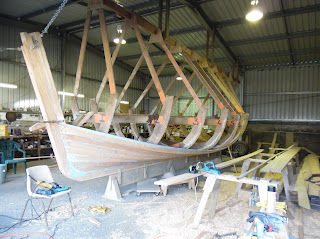There are many more shipwrecks in the waters surrounding Norfolk Island than is commonly known. One of these lesser known shipwreck stories is that of the Oscar Robinson, a wooden hulled sailing vessel of 61 ton that became stranded on the reef close to the narrow entrance into Emily Bay.
The Oscar Robinson was originally a trader off the coast of NSW, built in 1883 at Williams River in NSW and registered in Sydney to Mr John Pinto of Balmain. This schooner became a regular trader between Sydney, Lord Howe and Norfolk Island, providing a vital freight and passenger service between these ports.
On this particular voyage in January 1898 she was headed from Sydney to Noumea via Lord Howe and Norfolk Island; offloading passengers and loading up with fifteen ton of onions at Norfolk. The ship was anchored off shore at Kingston, towards the south. Captain Garth was not on board having left the vessel in charge of the mate Mr. Bezer and a local pilot, Guildford Adams. On 16 January about 2 p.m. a heavy, black, nasty-looking squall gathered to the south-west, the decision was taken to manoeuvre the schooner out to sea. The wind being favourable for this direction her course was set to go between Nepean and Norfolk Islands, a passage occasionally used by small vessels. Unfortunately the squall produced little wind and that which did arrive came from the east south east put the vessel in difficulty. The anchor was lifted and she started with the foresail and inner jib. Shortly afterwards the mainsail was partly hoisted, then lowered and the outer jib set. All to no avail, the vessel drifted dangerously close to the breakers and an unsuccessful attempt was made to change course but as she would neither tack nor wear she struck the reef.
Onshore the desperate scene was witnessed by many including the Norfolk Island Council of Elders as they were just about to hold a meeting. Seeing the dangerous position of the vessel, the elders rushed to the boats, two were quickly launched but they were not able to reach the schooner before she struck. The rescue boats proceeded through the narrow passage into Emily Bay and worked continuously throughout the afternoon until all the cargo and mail was recovered, fortunately the two men on board were not hurt beyond exhaustion and disappointment and everything was landed undamaged. The Oscar Robinson was the second trading vessel lost at Norfolk within a five year period, the other was the Mary Ogilvie, both ships were under the command of Captain W.G Garth, we can only imagine his dismay.
During the evening Mr Young and a crew of locals made fast a line from the stranded vessel to a pine tree, they carried a small anchor and hawser (travelling block) out into the bay and at high tide that night the vessel floated off the reef into Emily Bay, where she sank in shallow water.
The Chief Magistrate appointed Captain Bates, Captain Champion, Sen. and Mr Snell as surveyors to survey the vessel, and an auctioneer for its sale. The next day the wreck was surveyed and it was recommended that she be sold. She went to auction on 20 January, the hammer went down on the sale at £46 10s and Mr. Charles Chase Ray Nobbs was the new owner of the sunken Oscar Robinson.
Thirty men and boys were employed with casks, buckets and pumps to bale her out at low tide, succeeding in keeping the water down and managing to take her broadside onto the beach. The men from the No. 2 whaling company were then engaged and put her further up onto the east corner of Emily Bay. There begun the stripping of the copper sheathing and other repairs, most people who had carts and other appliances also provided assistance. It is not known whether this work was undertaken for remuneration from CCR Nobbs however it is known that Captain Garth was presented with a salvage claim for £299.
Charles Chase Ray Nobbs stated his intention to patch up the vessel and then send her to Sydney for final repairs. He intended to keep her for the inter-island trade. The Oscar Robinson was given a new master and a new name. The new master was Captain Bezer, the chief mate that had struggled alongside Guildford Adams attempting to save her from shipwreck. Agnes was the new name. CCR Nobbs renamed his new schooner after his wife Agnes and the Agnes was the first vessel to be registered at Norfolk Island.
Janelle Blucher


































































